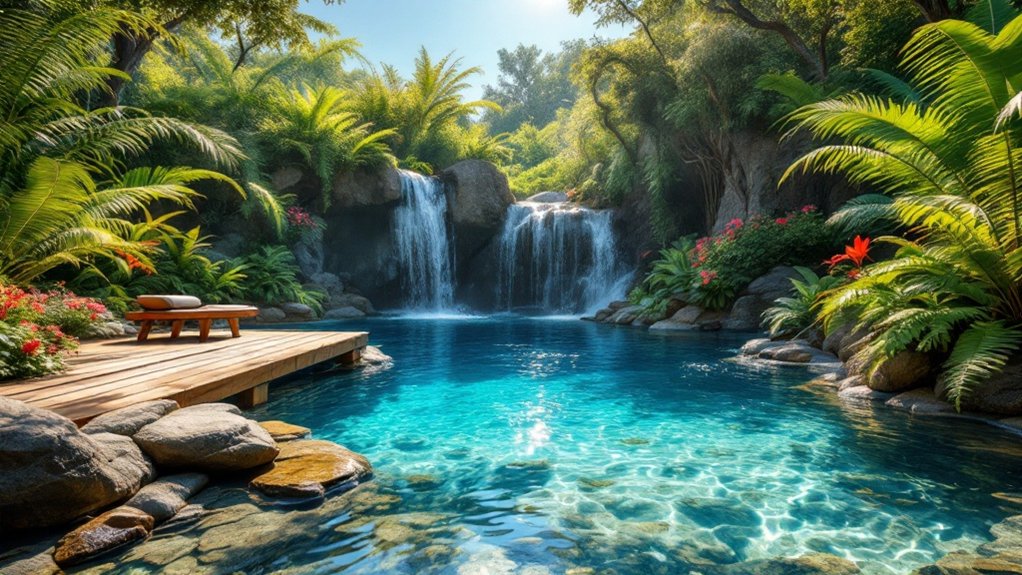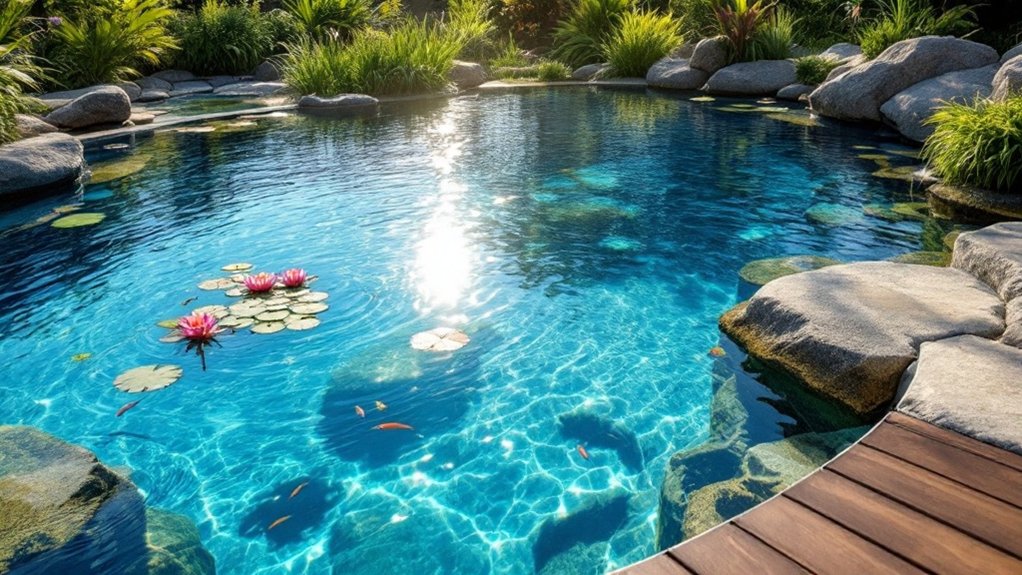Natural swimming pools offer a unique approach to leisure and relaxation. They combine beauty with environmental sustainability, creating spaces that are both inviting and beneficial. With a focus on low chemical usage and natural filtration, these pools provide a safe alternative for families and pets. The presence of native plants and wildlife further enhances their appeal. As awareness grows, the question remains: what advantages do these eco-friendly pools hold for modern living?
What Is a Natural Swimming Pool?
A natural swimming pool is an eco-friendly alternative to traditional pools, designed to integrate harmoniously with the surrounding environment. Unlike conventional pools that rely on chemical treatments to maintain water clarity, natural swimming pools utilize biological filtration systems. These systems incorporate plants and natural organisms to purify water, creating a self-sustaining ecosystem. The design typically features two zones: a swimming area and a regeneration zone filled with aquatic plants. This dual structure not only supports water purification but also enhances biodiversity. Natural swimming pools can be tailored to various landscapes, blending seamlessly into gardens or rural settings. Their maintenance often requires less energy and fewer chemicals, making them a sustainable choice for environmentally conscious homeowners.
The Aesthetic Appeal of Natural Swimming Pools
Natural swimming pools offer a unique aesthetic that seamlessly integrates with the surrounding landscape. Their organic design provides homeowners with innovative opportunities to create a visually striking environment. This blend of nature and artistry enhances the overall appeal of outdoor spaces.
Harmonious Landscape Integration
While traditional swimming pools often disrupt the natural beauty of their surroundings, natural swimming pools seamlessly blend into their environment, enhancing the overall aesthetic appeal of any landscape. These pools utilize native plants and organic materials, creating a serene oasis that harmonizes with the existing ecosystem. The use of natural stone, gravel, and aquatic vegetation not only provides a visually pleasing appearance but also promotes biodiversity. The gentle curves and organic shapes of these pools mimic natural bodies of water, further contributing to their integration into the landscape. This thoughtful design fosters a tranquil atmosphere, encouraging relaxation and connection with nature. As a result, natural swimming pools elevate the beauty of outdoor spaces, making them a desirable addition to any property.
Unique Design Opportunities
The aesthetic appeal of natural swimming pools lies in their ability to offer unique design opportunities that cater to a wide range of tastes and preferences. Unlike traditional pools, these eco-friendly alternatives allow for creativity in shaping and landscaping. Designers can integrate natural materials such as stone, wood, and native plants, creating a seamless change between the pool and surrounding environment. Custom features like waterfalls, rock formations, or sandy beach entries enhance visual interest and provide a resort-like atmosphere. Colorful aquatic plants and wildlife can be incorporated to enrich the ecosystem, further enhancing the pool’s beauty. This versatility guarantees that each natural swimming pool is not only a functional space but also a stunning focal point in any outdoor setting.
Enhancing Biodiversity in Your Backyard
Creating a natural swimming pool not only offers a revitalizing place to swim but also serves as a catalyst for enhancing biodiversity in one’s backyard. By incorporating native plants and natural filtration systems, these pools attract a variety of wildlife, including birds, frogs, and beneficial insects. The introduction of aquatic plants provides essential habitats and food sources, fostering a balanced ecosystem. Additionally, the absence of harsh chemicals allows for a healthy environment where microorganisms thrive, further supporting local biodiversity. This harmonious setting encourages pollination and pest control, ultimately contributing to a more resilient garden. Homeowners can enjoy the aesthetic appeal of a natural oasis while actively promoting the well-being of local flora and fauna.
Low Chemical Usage and Its Benefits
Natural swimming pools promote low chemical usage, greatly reducing exposure to harmful substances for both humans and aquatic life. This approach fosters a healthier ecosystem balance, allowing native flora and fauna to thrive. Additionally, sustainable water management practices integrated into these pools contribute to environmental conservation efforts.
Reduced Chemical Exposure
While many traditional swimming pools rely heavily on chemicals to maintain water quality, natural swimming pools offer a revitalizing alternative with considerably reduced chemical exposure. This reduction not only benefits swimmers but also the surrounding environment. By utilizing biological filtration systems, these pools rely on plants and natural processes to keep the water clean and clear. The absence of harsh chemicals minimizes the risk of skin irritations and respiratory issues commonly associated with chlorinated water. In addition, reduced chemical usage contributes to lower maintenance costs and a more sustainable approach to pool management. As a result, natural swimming pools create a safer and more enjoyable swimming experience, promoting a healthier lifestyle for individuals and families alike.
Healthier Ecosystem Balance
Because natural swimming pools prioritize low chemical usage, they foster a healthier ecosystem balance that benefits both aquatic life and human swimmers. By minimizing the introduction of synthetic chemicals, these pools create a more stable environment for beneficial microorganisms, plants, and fish. This natural filtration system effectively maintains water clarity and quality, promoting biodiversity. The absence of harsh chemicals reduces the risk of harmful algae blooms, which can threaten aquatic health and swimmer safety. Additionally, swimmers enjoy a more pleasant experience in water that is free from chlorine and other irritants, leading to fewer skin and eye irritations. Overall, low chemical usage in natural swimming pools not only enhances the aquatic ecosystem but also aligns with a more sustainable approach to leisure.
Sustainable Water Management
Sustainable water management in natural swimming pools relies on greatly reduced chemical usage, which has numerous environmental benefits. By minimizing the use of synthetic chemicals, these pools promote healthier water ecosystems, supporting biodiversity and encouraging natural filtration processes. This approach greatly lessens the risk of chemical runoff, which can harm local waterways and wildlife. Additionally, lower chemical dependency results in safer swimming conditions for users, particularly children and pets. The natural methods employed in these pools, such as aquatic plants and beneficial bacteria, maintain water clarity and quality without the adverse effects of traditional chlorine-based systems. Overall, the sustainable practices associated with natural swimming pools foster a more balanced interaction between human recreation and environmental stewardship.
Natural Filtration Systems Explained
Natural filtration systems serve as the backbone of natural swimming pools, providing an eco-friendly alternative to traditional chemical treatments. These systems typically utilize a combination of biological and mechanical processes to maintain water clarity and quality. At the heart of the filtration process is a planted regeneration zone, where aquatic plants, beneficial bacteria, and microorganisms work together to break down organic matter and absorb nutrients. Water circulates through this zone, allowing it to be naturally filtered before returning to the swimming area. This approach not only purifies the water but also promotes biodiversity, creating a balanced ecosystem. By mimicking natural water bodies, these systems facilitate a healthier swimming environment while minimizing the use of synthetic chemicals, enhancing user experience and environmental sustainability.
Cost-Effectiveness Over Time
One significant advantage of natural swimming pools lies in their cost-effectiveness over time. Unlike traditional pools, which require ongoing chemical treatments, regular maintenance, and significant water expenses, natural pools utilize biological filtration systems that reduce these costs. Once established, the need for chemicals is minimal, leading to lower annual expenditures. The plants and ecosystem within these pools also contribute to their self-sustainability, diminishing the need for constant intervention. Additionally, natural swimming pools have a longer lifespan due to durable construction materials and the absence of harsh chemicals that can degrade surfaces. Overall, while the initial investment may be higher, the long-term savings in maintenance and operating costs position natural swimming pools as a financially sound choice for many homeowners.
Health Benefits of Swimming in Natural Water
While traditional swimming pools often rely on synthetic chemicals that can irritate the skin and eyes, swimming in natural water provides a rejuvenating alternative that promotes overall health. Natural swimming pools utilize biological filtration systems, enabling swimmers to enjoy cleaner and chemical-free environments. This exposure to natural elements can improve skin conditions, as natural water is typically gentler and less irritating than chlorinated alternatives. Additionally, swimming in natural water enhances cardiovascular fitness and builds muscle strength, contributing to improved physical health. The tranquil settings of these pools often reduce stress levels, fostering mental well-being. Moreover, the interaction with nature can elevate mood and provide a sense of connection, enhancing the overall experience and promoting a holistic approach to health.
Maintenance Tips for Natural Swimming Pools
To guarantee the longevity and cleanliness of natural swimming pools, regular maintenance is essential. Routine tasks include monitoring water levels, verifying proper filtration, and maintaining the balance of beneficial bacteria. Cleaning debris such as leaves and twigs is vital to prevent algae growth and keep the water clear. Additionally, checking the plant life around the pool is important; trimming overgrown vegetation can enhance aesthetics and improve water quality. Testing the water regularly for pH and nutrient levels verifies a healthy ecosystem. Seasonal maintenance, such as winterizing the pool and inspecting the liner, should not be overlooked. By adhering to these maintenance tips, pool owners can enjoy a beautiful, functional natural swimming pool for years to come.
Designing Your Perfect Natural Swimming Pool
When considering the design of a perfect natural swimming pool, homeowners should start by envisioning a harmonious blend of aesthetics and functionality. Key elements include selecting a suitable location that enhances the natural landscape while ensuring privacy. Incorporating native plants and stones can create a seamless connection between the pool and its surroundings. Homeowners should also consider water circulation systems that mimic natural ecosystems, promoting clarity and cleanliness. Depth variations can create diverse swimming areas, while shallow zones offer safe play spaces for children. Additionally, integrating features like waterfalls or rock formations can enhance visual appeal and provide soothing sounds. Ultimately, the design should reflect personal style while prioritizing environmental sustainability, ensuring a beautiful and functional outdoor retreat.
Frequently Asked Questions
How Do Natural Swimming Pools Impact Local Wildlife?
The impact of natural swimming pools on local wildlife is significant; they create habitats, support biodiversity, and attract various species. These ecosystems enhance water quality and promote a balanced environment, benefiting both aquatic and terrestrial life.
Can I Retrofit an Existing Pool Into a Natural Swimming Pool?
Retrofitting an existing pool into a natural swimming pool is possible, but it requires significant modifications. Factors such as filtration systems and plant integration must be carefully considered to guarantee effective transformation and maintain water quality.
Are Natural Swimming Pools Safe for Children and Pets?
Natural swimming pools can be safe for children and pets when properly designed and maintained. They often use natural filtration systems, reducing harmful chemicals, but supervision is essential to guarantee safety during swimming activities.
What Plants Are Best for Natural Swimming Pools?
The best plants for natural swimming pools typically include native aquatic species like water lilies, cattails, and submerged plants such as hornwort. These plants enhance water quality, provide habitat, and create a balanced ecosystem for swimming.
How Long Does It Take to Build a Natural Swimming Pool?
The construction of a natural swimming pool typically requires four to six weeks, depending on size and complexity. Factors such as weather conditions and material availability can influence the timeline for completion considerably.
Conclusion
To sum up, natural swimming pools offer a unique blend of beauty, sustainability, and health benefits. By utilizing biological filtration and minimizing chemical exposure, they create safe environments for families while enhancing local ecosystems. The aesthetic appeal and lower maintenance costs further solidify their value as a serene retreat. Embracing a natural swimming pool not only enriches personal well-being but also fosters a deeper connection with nature, making it a wise choice for environmentally conscious individuals.




